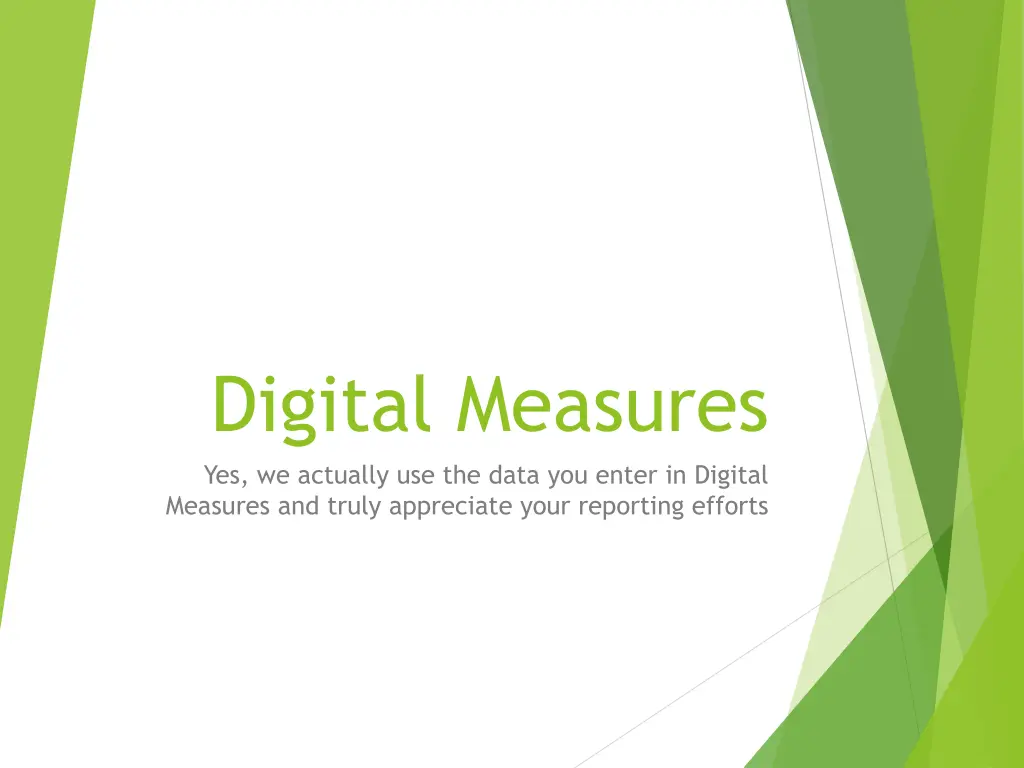
Utilizing Digital Measures for Comprehensive Reporting
"Explore the uses and importance of Digital Measures in various reporting tasks, such as annual performance reviews, board of regents measures, USDA-NIFA reports, and more. Learn how to correctly input data and key reporting fields to maximize reporting efficiency and accuracy."
Download Presentation

Please find below an Image/Link to download the presentation.
The content on the website is provided AS IS for your information and personal use only. It may not be sold, licensed, or shared on other websites without obtaining consent from the author. If you encounter any issues during the download, it is possible that the publisher has removed the file from their server.
You are allowed to download the files provided on this website for personal or commercial use, subject to the condition that they are used lawfully. All files are the property of their respective owners.
The content on the website is provided AS IS for your information and personal use only. It may not be sold, licensed, or shared on other websites without obtaining consent from the author.
E N D
Presentation Transcript
Digital Measures Yes, we actually use the data you enter in Digital Measures and truly appreciate your reporting efforts
Some uses for Digital Measures Annual Performance Review Board of Regents Performance Measures USDA-NIFA Accomplishments Report USDA-NIFA Plan of Work USDA-NIFA Multi-state and Integrated Research Report Department Reports
Master Key Reporting Field Key Reporting Field Key Reporting Field Key Reporting Field
Make sure you enter as decimal 0.50 = 50% of your time
Be sure to enter from and to dates: From: January 1, 2017 To: December 31, 2017 Key Reporting Field Key Reporting Fields
Master Key Reporting Field Key Reporting Fields Key Reporting Fields
Key Reporting Fields Key Reporting Fields
NIFA Summary: January 1, 2016 - December 31, 2016 Childhood Obesity, Nutrition and Community Run the NIFA Summary: Extension report to show by USDA Issue area your: number of events/activities for each knowledge area total direct contacts by race and ethnicity the number of participants gained knowledge (Gained Knowledge) and the number of participants apply practices (Gained Practice). 4-H and Youth Development Programs Community and Economic Development Human Health Human Nutrition Individual and Family - Home Individual and Family - Other Individual and Family - Relationships Individual and Family - Resource Direct Contacts (New Categories) Who F A wh 69717 af 2689 pi 286 as 1188 in 1326 tw 567 un 7878 hi 4261 964 57 52 84 29 10 47 52 F Y M A M Y 139060 3311 869 1455 1700 1318 10771 40444 1501 165 764 742 256 4855 121498 2882 734 1075 1455 4528 8895 13742 2039 13346 Race Direct Contacts (New Categories): wh = White af = Black or African American pi = Native Hawaiian or Other Pacific Islander as = Asian in = American Indian or Alaskan Native tw = Two or more races un = Undetermined Ethnicity Categories: hi = Hispanic or Latino Total Adults=132378 Total Youths=299551 Gainded Knowledge: 240386 Gained Practice: 131979 Anumbers: A00015030 (Marilyn Albertson), A00350434 (Shannon Babb), A00015654 (Jeffrey Banks), A00015655 (Sterling Banks), A00316790 (Naomi Brower), A00016514 (Jolene Bunnell), A00015128 (Carl Chapman), A00315022 (Amanda Christensen), A00028209 (Darlene Christensen), A00015037 (Troy Cooper), A00641185 (Joseph
Contact Information: Stan Guy stanley.guy@usu.edu (435) 797-3221
